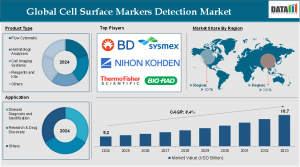Cell surface marker detection is transforming diagnostics with tech breakthroughs and growing use in cancer, autoimmune, and stem cell research.
At an 8.4% CAGR, the global market for cell surface markers detection is advancing toward $10.7B by 2033, fueled by innovation in oncology and immunology.”
AUSTIN, TX, UNITED STATES, June 3, 2025 /EINPresswire.com/ -- Cell surface markers detection market reached a value of US$ 5.2 billion in 2024 and is expected to grow significantly, reaching US$ 10.7 billion by 2033. This growth reflects a robust compound annual growth rate (CAGR) of 8.4% during the forecast period from 2025 to 2033. The upward trajectory is fueled by rapid advancements in diagnostic technology, increasing emphasis on precision medicine, and the growing burden of chronic and infectious diseases globally.— DataM Intelligence
Download Exclusive Sample Report Here: https://www.datamintelligence.com/download-sample/cell-surface-markers-detection-market
Market Drivers and Growth Factors
The market is gaining momentum due to a confluence of medical and technological advancements:
Precision Medicine Surge: With the rise of individualized treatment plans, the need for accurate identification of cell types and disease markers has intensified. Cell surface marker detection plays a critical role in mapping cellular pathways, especially in oncology, immunology, and stem cell research.
Rise in Chronic and Autoimmune Diseases: Conditions such as cancer, rheumatoid arthritis, and multiple sclerosis are on the rise, demanding early and specific diagnostic tools. These diseases often exhibit changes in cell surface proteins, making marker detection essential for diagnosis and treatment monitoring.
Technological Advancements: Tools such as flow cytometry, mass cytometry, and advanced imaging platforms have significantly enhanced the precision and speed of detecting specific cell surface markers. Innovations in assay development, reagents, and antibodies have also expanded the utility of these detection methods.
Expanding Research Activities: As global investment in molecular biology, cell biology, and immunophenotyping grows, research institutions and biotech firms are relying increasingly on surface marker technologies to develop targeted therapies and understand disease mechanisms at the cellular level.
Regional Outlook
North America
North America continues to dominate the market, backed by strong healthcare infrastructure, early adoption of advanced technologies, and a well-established biotech and pharmaceutical ecosystem. The presence of numerous academic and research institutions also contributes to high market penetration and product innovation.
Europe
Europe holds a substantial market share due to its emphasis on public health, high-quality clinical research, and stringent regulatory standards. Countries like Germany, France, and the UK are leading in clinical adoption, particularly in cancer diagnostics and hematology.
Asia-Pacific
The Asia-Pacific region is expected to witness the fastest growth during the forecast period. Factors such as increasing healthcare investments, a large and aging population, and expanding biotech industries in countries like China, India, and Japan are accelerating demand. Local governments are also supporting research and manufacturing through favorable policies and funding initiatives.
Key Market Players
Becton, Dickinson and Company (BD)
NIHON KOHDEN CORPORATION
Sysmex Corporation
Thermo Fisher Scientific Inc.
Nexcelom Bioscience LLC
Beckman Coulter, Inc.
Agilent Technologies Inc.
Bio-Rad Laboratories, Inc.
Cytek Biosciences Inc
Miltenyi Biotec
Recent Developments
Latest News – USA
In the United States, recent innovations have further solidified the country's position as a global leader in this market:
Emerging Diagnostic Platforms: A major push has been observed in enhancing mass spectrometry and flow cytometry platforms with AI-driven analytics, making them faster and more accurate. This is particularly valuable in identifying rare cell populations and early disease markers.
Healthcare Reforms Supporting Precision Medicine: Policy-driven incentives supporting genomic medicine and advanced diagnostics are encouraging wider adoption of surface marker detection tools in clinical practice.
Research and Clinical Trials Surge: Leading U.S.-based research universities and biopharmaceutical firms are launching numerous trials focusing on immunotherapies and cell-based treatments, all of which depend heavily on reliable marker detection technologies.
Latest News – Japan
Japan is making noteworthy progress in the cell surface marker detection field, backed by both innovation and government support:
Product Expansion by Nihon Kohden and Sysmex: These Japanese firms are expanding their diagnostic and clinical product lines to include more automated and user-friendly cell analysis platforms, designed to meet the needs of both hospital labs and research institutions.
Focus on Aging Population: With one of the world’s oldest populations, Japan is focusing on early diagnosis of cancer, neurodegenerative disorders, and immune-related conditions, all of which rely on the identification of specific cellular markers.
Government-Backed Innovation Programs: The Japanese government has launched initiatives to support translational medicine and life sciences R&D, which includes investing in next-gen diagnostic tools and personalized healthcare systems.
Market Segmentation:
By Product: Flow Cytometry, Hematology Analyzers, Cell Imaging Systems, Reagents and Kits, Other.
By Application: Disease Diagnosis and Identifications, Research And Drug Discovery, Other.
By Region: North America, Europe, South America, Asia-Pacific, Middle East, and Africa.
Conclusion
The cell surface markers detection market is poised for sustained and substantial growth, propelled by a dynamic combination of medical needs, scientific advances, and expanding healthcare infrastructure. With increasing global emphasis on early and precise disease diagnosis, the role of cell surface markers in shaping the future of diagnostics and personalized medicine is more critical than ever.
As the market evolves, stakeholders who invest in innovation, quality, and accessibility will lead the way in transforming patient outcomes and driving healthcare forward in the coming decade.
Stay informed with the latest industry insights-start your subscription now: https://www.datamintelligence.com/reports-subscription
Cell Culture Market
3D Cell Culture Market
Sai Kumar
DataM Intelligence 4market Research LLP
+1 877-441-4866
email us here
Visit us on social media:
LinkedIn
X
Legal Disclaimer:
EIN Presswire provides this news content "as is" without warranty of any kind. We do not accept any responsibility or liability for the accuracy, content, images, videos, licenses, completeness, legality, or reliability of the information contained in this article. If you have any complaints or copyright issues related to this article, kindly contact the author above.


